Rediscovery of the Type Specimens of the Sarcopterygian Fishes Onychodus sigmoides and Onychodus hopkinsi from the Devonian of Ohio, USA
Abstract
:1. Introduction
- Their specific geographic provenance: whether from Milford, Delaware, or Sandusky, Ohio.
- Their stratigraphic provenance: Columbus Limestone or Delaware Limestone.
- Their age: Early Devonian or Middle Devonian.
- Their nomenclature: two distinct species or one species having variability in the shape of the parasymphysial teeth.
2. Scientific and Historical Importance
3. Materials and Methods
4. Nomenclature of Early-Named Onychodus Species
4.1. Onychodus sigmoides and O. hopkinsi from Ohio
4.2. Onychodus hopkinsi from New York
4.3. Onychodus ortoni from Ohio
5. Geographic and Stratigraphic Provenance of Onychodus sigmoides and O. hopkinsi
6. Revised Nomenclature, Biostratigraphy, and Lithofacies Distribution of Appalachian Basin Onychodus Species
6.1. Newberry’s Onychodus Species and Variation in Tooth Morphology
- 1857 Onychodus Newberry, p. 124 (original description).
- 1862 Onychodus Newberry–Newberry, p. 77
- 1873 Onychodus Newberry–Newberry, pp. 296–299.
- 1874 Onychodus Newberry–Newberry, pp. 294–297.
- 1889 Onychodus Newberry–Newberry, pp. 53–56.
- 1889 Onychodus Newberry–Miller, pp. 602–603.
- 1907 Onychodus Newberry–Eastman, pp. 168–169.
- 1918 Onychodus Newberry–Hussakof and Bryant, p. 178.
- 1944 Onychodus Newberry–Wells, p. 43
- 1996 Onychodus Newberry–Hansen, pp. 292–293.
- 1996 Onychodus Newberry–Janvier, pp. 198–199, fig. 4.74C–F.
- 2020 Onychodus Newberry–Mondéjar-Fernández, p. 574.
- 2022 Onychodus Newberry–Ciudad Real, Mondéjar Fernández, Vidal and Botella, p. 96.
- 2024 Onychodus Newberry–Babcock, 2024, pp. e2308621-7–e2308621-9.
- Diagnosis: Onychodontiform fish reaching a large size and having a single row of large, procurved to sigmoidal teeth on the paired parasymphysial plates; the parasymphysial plates rest on either side of the lower jaw symphysis. The teeth are simple, with plicidentine infolding only at the base, and are covered with finely striated enamel. Premaxilla is slender without a sensory-line canal; the maxilla is large, reaching the preopercular. The caudal fin is epicercal.
- Remarks: Janvier [3] recently provided a concise discussion of the characteristics that diagnose the genera included in the Onychodontiformes (or Onychodontida), and Ciudad Real et al. [32] recently discussed the data matrices used to reconstruct the phylogenetic relationships of the onychodonts among sarcopterygians. These sources and references therein provide further background to the interpretation of Onychodus and its phylogenetic history.
| Onychodus sigmoides Newberry, 1857 |
| Figure 1, Figure 2, and Figure 4A |
- 1853 Ganoid fish–Newberry, 1853, p. 13, fig. 2.
- 1857 Onychodus sigmoides Newberry, p. 124 (original description).
- 1857 Onychodus hopkinsi Newberry, p. 124 (original description).
- 1862 Onychodus hopkinsi Newberry, fig. 3.
- 1873 Onychodus sigmoides Newberry–Newberry, pp. 299–302, fig. p. 301, pl. 26, figs. 1–5; pl. 27, figs. 1–2.
- 1874 Onychodus sigmoides Newberry–Newberry, pp. 297–299, fig. p. 299, pl. 26, figs. 1–5; pl. 27, figs. 1–2.
- 1878 Onychodus sigmoides Newberry–Orton, p. 625.
- 1889 Onychodus sigmoides Newberry–Newberry, pp. 56–57, pl. 36, figs. 1–4; pl. 37, figs. 1–11.
- 1889 Onychodus sigmoides Newberry–Lesley, pp. 497–498, 8 figs.
- 1889 Onychodus sigmoides Newberry–Miller, p. 603, figs. 1150, 1151.
- 1889 Onychodus hopkinsi Newberry–Miller, p. 603 (in part).
- 1892 Onychodus sigmoides Newberry–Lesley, p. 1160, 5 figs.
- 1902 Onychodus sigmoides Newberry–Hay, p. 363 (see for additional synonymy).
- 1907 Onychodus sigmoides Newberry–Eastman, p. 169 (in part).
- 1907 Onychodus hopkinsi Newberry–Eastman, p. 169 (in part).
- ? 1907 Onychodus sp. indes. cf. O. sigmoides Newberry–Eastman, p. 169, pl. 1, fig. 3.
- 1907 Onychodus (sigmoides ?)–Eastman, p. 169, pl. 3, fig. 2.
- 1908 Onychodus sigmoides Newberry–Hussakof, pp. 57–58.
- 1918 Onychodus sigmoides Newberry–Hussakof and Bryant, pp. 178–181, text fig. 59, pl. 58, figs. 1–3.
- 1933 Onychodus Newberry–Moodie, fig. 20, 2–3.
- 1944 Onychodus sigmoides Newberry–Wells, pp. 43–45, pl. 3, figs. 28–38; pl. 4, figs. 19, 20,; pl. 8, figs. 7–11; text fig. 9.
- 1966 Onychodus sigmoides Newberry–Gardiner, pp. 91–93 (see for additional synonymy).
- 1996 Onychodus sigmoides Newberry–Hansen, pp. 292-293, figs. 21-10.2–21-10.4 (not fig. 21-10.1).
- 2014 Onychodus sp.–Wilson, p. 236, 3 figures p. 237 (not figure at left).
- 2017 Onychodus eriensis Mann, Rudkin, Evans, and Laflamme, pp. 234–241, fig. 2, tab. 1 (original description).
- 2017 Onychodus cf. eriensis Mann, Rudkin, Evans, and Laflamme, pp. 234–241, fig. 3.
- 2017 Onychodus sigmoides Newberry–Mann, Rudkin, Evans, and Laflamme, p. 240, fig. 5.
- Types: Lectotype (designated here), parasymphysial tooth, OSU 54751; and paralectotype, parasymphysial tooth, OSU 54752; both are from the OWU collection; from the Delaware Limestone (Lower Devonian, Eifelian), Campbell’s Quarry (now Blue Limestone Park), Delaware, Delaware County, Ohio, USA (Figure 4). Holotype of Onychodus hopkinsi Newberry, 1857, a subjective junior synonym, parasymphysial whorl, OSU 54753A (part) and counterpart 54753B (counterpart), from the OWU collection; from the Delaware Limestone (Lower Devonian, Eifelian), Campbell’s Quarry, Delaware, Delaware County, OH, USA.
- Diagnosis: Onychodus having four? to seven (usually five or six) slender to robust parasymphysial teeth, reaching about 60 mm in length; they are simple at the tips, procurved to recurved, and if recurved, recurvature occurs in the distal 10–35% of the tooth length above the basal flare. The teeth are morphologically dissimilar along the length of the parasymphysial plate; teeth in the proximal location show little recurvature, and recurvature in the teeth increases distally (anteriorly) along the parasymphysial. The lower jaw is distinctly curved, especially in large specimens; the jaw curves anteriorly from the middle of the dentary to the mandibular ramus; the anterior surface of the dentary ramus is flattened. Jaws are large, with up to about 50 teeth that decrease in size both anteriorly and posteriorly; the teeth are short, conical, and straight to slightly curved; the dermal bone is ornamented with large tubercles.
- Remarks: Prior to the rediscovery of Newberry’s original suite of type and examined specimens of Onychodus from the Delaware Limestone of Delaware, Ohio, and his examined specimen from Franklin, New York, considerable uncertainty about how to classify the North American species of Onychodus was introduced to the literature. Uncertainty arose, in part, from the publication of a distinctive seven-tooth parasymphysial whorl from the “Corniferous limestone” of Ohio under the names O. hopkinsi in 1862 [12] and O. sigmoides in 1873 [10] (reprinted in German, 1874 [13]) using the same woodcut illustration (herein, Figure 2C,D). Further complicating the uncertainty, Newberry [9,10,13] stated that his report [7] of O. hopkinsi from Ohio was erroneous despite his erection of the species-group name using a specimen (Figure 2A–C) from Ohio. Newberry [9,10,13] stated that teeth collected from the “Chemung” of New York instead fulfilled his species definition, but he never illustrated or specifically referred to any specimen as a substitute name-bearer (or neotype) for the species.
| Onychodus ortoni Newberry, 1889 |
| Figure 3 and Figure 4B |
- 1889 Onychodus ortoni Newberry, pp. 71–72, pl. 19, fig. 1, 1a (original description).
- 1889 Onychodus hopkinsi Newberry–Newberry, pp. 99–100.
- 1889 Onychodus hopkinsi Newberry–Miller, p. 603 (in part).
- 1902 Onychodus ortoni–Hay, p. 363.
- 1907 Onychodus hopkinsi Newberry–Eastman, p. 169 (in part), pl. 3, fig. 3; pl. 9, figs. 1, 2.
- 2024 Onychodus ortoni–Babcock, p. e2308621-9, fig. 1C.
- Holotype: Parasymphysial whorl, OSU 14154 (by monotypy); from the Huron Member of the Ohio Shale (Upper Devonian, Famennian), Perry Township (probably Flint Run [37]), Franklin County, Ohio, USA.
- Diagnosis: Onychodus having five to six slender parasymphysial teeth, reaching about 25 mm in length; they are simple at the tips and almost completely procurved except for a slight recurvature in the distal 1 to 2 mm. They are uniformly similar in morphology along the length of the parasymphysial plate.
- Remarks: Onychodus ortoni, which was previously known from only the holotype parasymphysial whorl (Figure 3B,C), was discussed recently [37]. The holotype is moderately large and shows relatively long but slender parasymphysial teeth; they are comparatively more slender than most of those in O. sigmoides at similar length, and they are much more uniform in shape along the parasymphysial. The arcuate, slender shape of the parasymphysial teeth, with a subtle deflection at the distal tips, is a useful characteristic for distinguishing teeth of O. ortoni from those of O. sigmoides. The differences between the teeth of the two species are most pronounced in moderately large specimens. A second parasymphysial whorl of O. ortoni (Figure 3D), apparently a topotype, is smaller than the holotype, but has teeth similar in shape to those in the holotype.
6.2. Biostratigraphy and Lithofacies Distribution
7. Summary
- The type specimens of both O. sigmoides and O. hopkinsi were collected from a limestone quarry in Delaware, Delaware County, Ohio. This quarry is inferred to be the former Campbell’s Quarry, which is now water-filled and on the site of Blue Limestone Park in Delaware.
- The lectotype and paralectotype parasymphysial teeth of O. sigmoides, as well as the holotype parasymphysial whorl of O. hopkinsi, were collected from the “fish beds” of the Delaware Limestone [33].
- All studied Onychodus remains from the Delaware Limestone at Delaware, Ohio, are referable to a single species, O. sigmoides, which shows two end-member morphologies of parasymphysial teeth.
- The original name-bearing specimens of O. sigmoides are the two parasymphysial teeth illustrated by Newberry [7], from which the larger tooth (Figure 1A) is selected as the lectotype. The holotype of O. hopkinsi is the parasymphyial whorl described by Newberry [7] and illustrated in 1862 [12] (Figure 2A,B). A parasymphysial whorl from the West Falls Group (“Chemung”; Upper Devonian, Frasnian) of Franklin, Delaware County, New York, examined by Newberry and evidently referred to in text [9,10,13], is now referred to as O. ortoni.
Funding
Institutional Review Board Statement
Data Availability Statement
Acknowledgments
Conflicts of Interest
Abbreviations
| AMNH | American Museum of Natural History, New York, New York |
| BMS | Buffalo Museum of Science, Buffalo, New York |
| NYSM | New York State Museum, Albany, New York |
| OSU | Orton Geological Museum, The Ohio State University, Columbus, Ohio |
| OWU | Ohio Wesleyan University, Delaware, Ohio |
References
- Carroll, R.L. Vertebrate Paleontology and Evolution; W.H. Freeman and Company: New York, NY, USA, 1988. [Google Scholar]
- Ahlberg, P.E. A re-examination of sarcopterygian interrelationships, with special reference to the Porolepiformes. Zool. J. Linn. Soc. 1991, 103, 241–287. [Google Scholar] [CrossRef]
- Janvier, P. Early Vertebrates. In Oxford Monographs on Geology and Geophysics; Clarendon Press: Oxford, UK, 1996; Volume 33. [Google Scholar]
- Moy-Thomas, J.A.; Miles, R.S. Palaeozoic Fishes, 2nd ed.; Chapman and Hall: London, UK, 1971. [Google Scholar]
- Long, J.A. Arthrodire predation by Onychodus (Pisces, Crossopterygii) from the Late Devonian Gogo Formation, Western Australia. West. Austral. Mus. Rec. 1991, 15, 479–481. [Google Scholar]
- Mann, A.; Rudkin, D.; Evans, D.C.; Laflamme, M. A large onychodontiform (Osteichthyes: Sarcopterygii) apex predator from the Eifelian-aged Dundee Formation of Ontario, Canada. Can. J. Earth Sci. 2017, 54, 233–241. [Google Scholar] [CrossRef]
- Newberry, J.S. Fossil fishes from the Devonian rocks of Ohio. Proc. Nat. Inst. 1857, 1, 119–126. [Google Scholar]
- White, C.A. Biographical Memoir of John Strong Newberry, 1822–1892; U.S. National Academy of Sciences, Biographical Memoirs; Judd & Detweiler: Washington, DC, USA, 1906; Volume 6, pp. 1–24. [Google Scholar]
- Newberry, J.S. The Paleozoic fishes of North America. In Monographs of the United States Geological Survey; Government Printing Office, Washington, DC, USA, 1889; Volume 16, pp. 1–340.
- Newberry, J.S. Descriptions of fossil fishes. In Report of the Geological Survey of Ohio. Volume I. Geology and Palaeontology. Part II. Palaeontology; Nevins & Myers: Columbus, OH, USA, 1873; pp. 247–355. [Google Scholar]
- Newberry, J.S. Fossil fishes of the Cliff limestone. Ann. Sci. 1853, 1, 12–13. [Google Scholar]
- Newberry, J.S. Notes on American fossil fishes. Am. J. Sci. 1862, s2-34, 73–78. [Google Scholar] [CrossRef]
- Newberry, J.S. Beschreibung der fossilen Fische. In Bericht über die Geologische Aufnahme von Ohio. I. Band. Geologie und Paläontologie. II, Theil. Paläontologie; Louis Heinmiller, Columbus, OH, USA, 1874; pp. 247–350.
- Eastman, C.R. Devonic fishes of the New York formations. In Memoirs of the New York State Museum; New York State Education Department: Albany, NY, USA, 1907; Volume 10, pp. 1–235. [Google Scholar]
- Hooker, W. Differentiating the parasymphysial teeth of two species of Eifelian †Onychodus (Osteichthyes, Sarcopterygii) from the Onondaga-Union Springs contact of central New York. In Proceedings of the Geological Society of America Abstracts with Programs Joint 72nd Annual Southeastern/58th Annual Northeastern Section Meeting, San Francisco, CA, USA, 19 March 2023; p. 39-2. [Google Scholar] [CrossRef]
- Moodie, R.L. A popular guide to the nature and the environment of the fossil vertebrates of New York. In New York State Museum Handbooks; New York. In New York State Museum Handbooks; New York State Education Department: Albany, NY, USA, 1933; Volume 12, pp. 1–122. [Google Scholar]
- Stauffer, C.R. The Middle Devonian of Ohio; Ohio Division of Geological Survey Bulletin, 4th Series No. 10; Geological Survey of Ohio: Columbus, OH, USA, 1909; pp. 1–204. [Google Scholar]
- Crowl, G.H. History of the Geology and Geography Department, Ohio Wesleyan University. Ohio J. Sci. 1979, 79, 15–17. [Google Scholar]
- Babcock, L.E. Type specimens of the sarcopterygian fishes Onychodus sigmoides and Onychodus hopkinsi from the Devonian of Ohio rediscovered. Geol. Soc. Am. Abstr. Programs 2025, 57, 409043. [Google Scholar] [CrossRef]
- Woodward, A.S. The Palaeozoic fishes of North America. Nature 1890, 43, 146–147. [Google Scholar]
- Hansen, M.C.; Collins, H.R. A brief history of the Ohio Geological Survey. Ohio J. Sci. 1979, 79, 3–14. [Google Scholar]
- Andrews, S.M. Interrelationships of crossopterygians. Interrelat. Fishes 1973, 53 (Suppl. 1), 138–177. [Google Scholar]
- Schultze, H.-P. Crossopterygier mit heterozerker Schwanzflosse aus dem Oberdevon Kanadas, nebst Onychodontida-Resten aus dem Mitteldevons, Spaniens und dem Karbon der USA. Paleontogr. Abt. A 1973, 143, 188–203. [Google Scholar]
- Cloutier, R.; Ahlberg, P.E. Morphology, characters, and the interrelationships of basal sarcopterygians. In Interrelationships of Fishes; Stiassny, M.L.J., Parenti, L., Johnson, G.D., Eds.; Academic Press: London, UK, 1996; pp. 445–479. [Google Scholar]
- Zhu, M.; Schultze, H.-P. The oldest sarcopterygian fish. Lethaia 1997, 30, 293–304. [Google Scholar]
- Forey, P.L. History of the Coelacanth Fishes; Chapman & Hall: London, UK, 1998. [Google Scholar]
- Andrews, S.M.; Long, J.A.; Ahlberg, P.; Barwick, R.; Campbell, K. The structure of the sarcopterygian Onychodus jandemarrai n. sp. from Gogo, Western Australia: With a functional interpretation of the skeleton. Earth Environ. Sci. Trans. R. Soc. Edinb. 2006, 96, 197–307. [Google Scholar] [CrossRef]
- Young, G.C.; Schultze, H.-P. New osteichthyans (bony fishes) from the Devonian of Central Australia. Mitteil. Mus. Naturk. Berlin Geowiss. Reihe 2005, 8, 13–35. [Google Scholar]
- Johanson, Z.; Long, J.A.; Talent, J.A.; Janvier, P.; Warren, J.W. New onychodontiform (Osteichthyes; Sarcopterygii) from the Lower Devonian of Victoria, Australia. J. Paleontol. 2007, 81, 1031–1043. [Google Scholar] [CrossRef]
- Lu, J.; Zhu, M. An onychodont fish (Osteichthyes, Sarcopterygii) from the Early Devonian of China, and the evolution of the Onychodontiformes. Proc. R. Soc. Lond. 2010, 277, 293–299. [Google Scholar] [CrossRef]
- Mondéjar-Fernández, J. A new onychodont (Osteichthyes; Sarcopterygii) from the Middle Devonian of Morocco and its bearing on early osteichthyan evolution. J. Syst. Paleontol. 2020, 18, 573–606. [Google Scholar] [CrossRef]
- Real, M.C.; Mondéjar-Fernández, J.; Vidal, D.; Botella, H. Is Onychodontida (Osteichthyes, Sarcopterygii) monophyletic? Assessing discordant phylogenies with quantitative comparative cladistics. Span. J. Paleontol. 2022, 37, 87–100. [Google Scholar] [CrossRef]
- Orton, E. Geology of Franklin County. In Report of the Geological Survey of Ohio, Volume III. Geology and Palaeontology. Part I. Geology; Nevins & Myers, Columbus, OH, USA, 1878; pp. 596–646.
- Seilacher, A.; Reif, W.-E.; Westphal, F. Sedimentological, ecological and temporal patterns of fossil Lagerstätten. P. Trans. R. Soc. Lond. B 1985, 311, 5–23. [Google Scholar]
- Babcock, L.E. Marine arthropod Fossil-Lagerstätten. J. Paleontol. 2025, 99, 1–18. [Google Scholar] [CrossRef]
- Lesley, J.P. A Dictionary of the Fossils of Pennsylvania and Neighboring States Named in the Reports and Catalogues of the Survey. Vol. 2; Geological Survey of Pennsylvania, Report, p. 4; Geological Survey of Pennsylvania: Harrisburg, PA, USA, 1889; pp. 439–914. [Google Scholar]
- Babcock, L.E. Some vertebrate types (Chondrichthyes, Actinopterygii, Sarcopterygii, and Tetrapoda) from two Paleozoic Lagerstätten of Ohio, U.S.A. J. Vert. Paleont. 2024, 44, e2308621. [Google Scholar] [CrossRef]
- Prosser, C.S. The Delaware Limestone. J. Geol. 1905, 13, 413–442. [Google Scholar] [CrossRef]
- Newberry, J.S. Geological Structure of Ohio–Devonian System. In Report of the Geological Survey of Ohio, Volume I. Geology and Palaeontology. Part I. Geology; Nevins & Myers: Columbus, OH, USA, 1873; pp. 140–167. [Google Scholar]
- Westgate, L.G. Geology of Delaware County; Geological Survey of Ohio Bulletin, 4th Series No. 30; Geological Survey of Ohio: Columbus, OH, USA, 1926; pp. 1–147. [Google Scholar]
- Ver Straeten, C.A. Basinwide stratigraphic synthesis and sequence stratigraphy, upper Pragian, Emsian and Eifelian stages (Lower to Middle Devonian), Appalachian Basin. In Devonian Events and Correlations; Becker, R.T., Kirchgasser, W.T., Eds.; Geological Society of London Special Publications: Bath, UK, 2007; Volume 278, pp. 39–81. [Google Scholar]
- DeSantis, M.K.; Brett, C.E.; Straeten, C.A.V. Persistent depositional sequences and bioevents in the Eifelian (early Middle Devonian) of eastern Laurentia: North American evidences of the Kacak Events? In Devonian Events and Correlations; Becker, R.T., Kirchgasser, W.T., Eds.; Geological Society of London Special Publications: Bath, UK, 2007; Volume 278, pp. 83–104. [Google Scholar] [CrossRef]
- Stauffer, C.R.; Hubbard, G.D.; Bownocker, J.A. Geology of the Columbus Quadrangle; Geological Survey of Ohio Bulletin, 4th Series No. 14; Geological Survey of Ohio: Columbus, OH, USA, 1911; pp. 1–133. [Google Scholar]
- Ver Straeten, C.A. The classic Devonian of the Catskill Front: A foreland basin record of Acadian orogenesis. In Proceedings of the New York State Geological Association, 81st Annual Meeting Guidebook, New Paltz, NY, USA, 25–27 September 2009; Volume 7, pp. 7-1–7-54. [Google Scholar]
- Roden, M.K.; Parrish, R.R.; Miller, D.S. The absolute age of the Eifelian Tioga Ash Bed, Pennsylvania. J. Geol. 1990, 98, 282–285. [Google Scholar] [CrossRef]
- Hussakof, W.; Bryant, W.L. Catalog of the fossil fishes in the Museum of the Buffalo Society of Natural Sciences. Bull. Buffalo Soc. Nat. Sci. 1918, 12, 1–346. [Google Scholar]
- Wells, J.W. Middle Devonian bone beds of Ohio. Geol. Soc. Amer. Bull. 1944, 55, 273–302. [Google Scholar] [CrossRef]
- Stewart, G.A.; Sweet, W.C. Conodonts from the Middle Devonian bone beds of central and west-central Ohio. J. Paleontol. 1956, 30, 261–273. [Google Scholar]
- Orton, E. Geological Map of Ohio; Geology of Ohio; Report of the Geological Survey of Ohio, Volume VI, insert; Geological Survey of Ohio: Columbus, OH, USA, 1888. [Google Scholar]
- Wells, J.W. Fish remains from the Middle Devonian bone beds of the Cincinnati Arch region. Palaeontogr. Am. 1944, 3, 1–62. [Google Scholar]
- Romer, A.S. Herpetichthyes, Amphibiodei, Choanichthyes or Sarcopterygii? Nature 1955, 176, 126. [Google Scholar] [CrossRef]
- Woodward, A.S. Catalogue of the Fossil Fishes in the British Museum (Natural History), Cromwell Road, S.W., Part 2, Containing the Elasmobranchii (Acanthodii), Holocephali, Ichthyodrulites, Ostracodermi, Dipnoi, and Teleostomi (Crossopterygii and Chondrostrean Actinopterygii); Taylor and Francis: London, UK, 1891. [Google Scholar]
- Westoll, T.S. Devonian fish biostratigraphy. In The Devonian System: Special Papers in Palaeontology 23; House, M.R., Scrutton, C.T., Bassett, M.G., Eds.; The Palaeontological Association: London, UK, 1979; pp. 341–353. [Google Scholar]
- Long, J.A. (Ed.) Early-Middle Palaeozoic vertebrate extinction events. In Palaeozoic Vertebrate Biostratigraphy and Biogeography; Johns Hopkins University Press: Baltimore, MD, USA, 1993; pp. 54–63. [Google Scholar]
- International Commission on Zoological Nomenclature. International Code of Zoological Nomenclature, 4th ed.; Ride, W.D.L., Cogger, H.G., Dupuis, C., Kraus, O., Minelli, A., Thompson, F.C., Tubbs, P.K., Eds.; International Trust for Zoological Nomenclature: London, UK, 2000. [Google Scholar]
- Miller, S.A. North American Geology and Palaeontology for the Use of Amateurs, Students, and Scientists; Western Methodist Book Concern: Cincinnati, OH, USA, 1889. [Google Scholar]
- Lesley, J.P. A Summary Description of the Geology of Pennsylvania, Vol. II. Describing Upper Silurian and Devonian Formations; Pennsylvania Geological Survey: Harrisburg, PA, USA, 1892; pp. 721–1628. [Google Scholar]
- Hay, O.P. Bibliography and Catalogue of the Fossil Vertebrata of North America. Bull. U.S. Geol. Surv. 1902, 179, 868. [Google Scholar]
- Gardiner, B.G. Catalogue of Canadian fossil fishes. In Royal Ontario Museum and University of Toronto Life Sciences Contributions, No. 68; University of Toronto Press, Toronto, ON, Canada, 1966.
- Hussakof, W. Catalogue of the type and figured specimens of fossil vertebrates in the American Museum of Natural History. Part I.—Fishes. Bull. Am. Mus. Nat. Hist. 1908, 25, 1–103. [Google Scholar]
- Wilson, K.A. Field Guide to the Devonian Fossils of New York; Paleontological Research Institution Special Publications; Paleontological Research Institution: Ithaca, NY, USA, 2014; Volume 44, pp. 1–260. [Google Scholar]
- Hansen, M.C. Phylum Chordata–vertebrate fossils. In Fossils of Ohio; Feldmann, R.M., Hackathorn, M., Eds.; Ohio Division of Geological Survey Bulletin No. 70; Ohio Division of Geological Survey Bulletin: Columbus, OH, USA, 1996; pp. 288–369. [Google Scholar]
- Lindley, I.D. Acanthodian, onychodontid and osteolepid fish from the middle–upper Taemas Limerstone (Early Devonian), Lake Burrinjuck, New South Wales. Alcheringa 2002, 26, 103–126. [Google Scholar] [CrossRef]
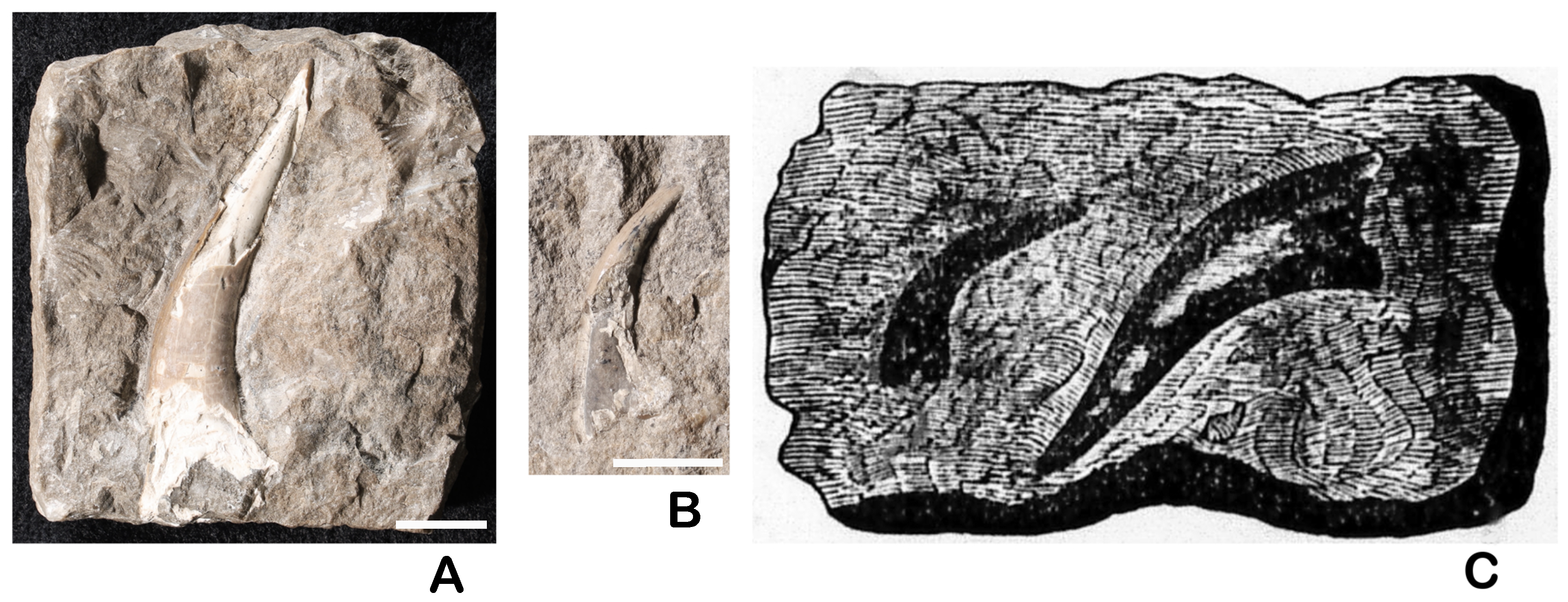
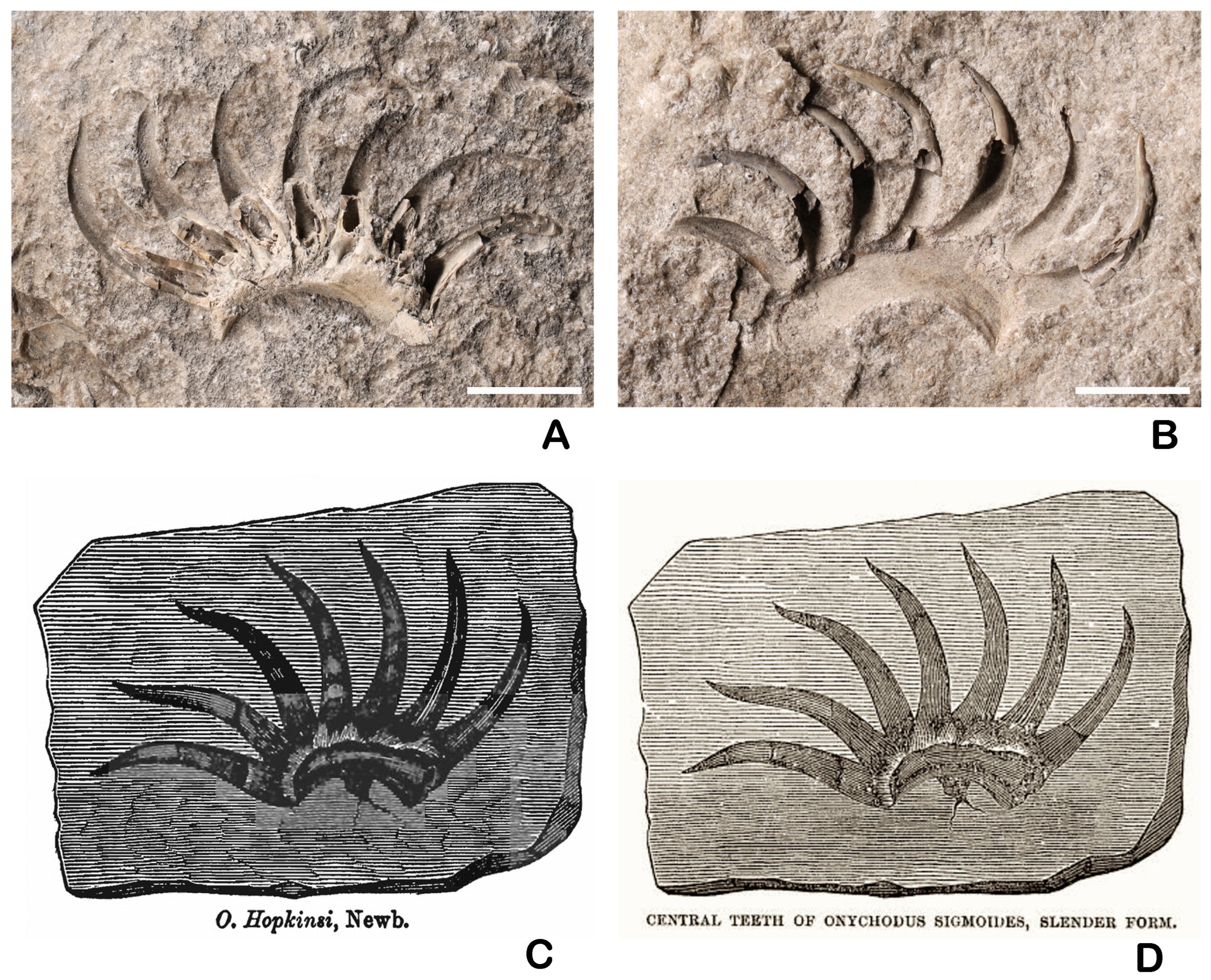
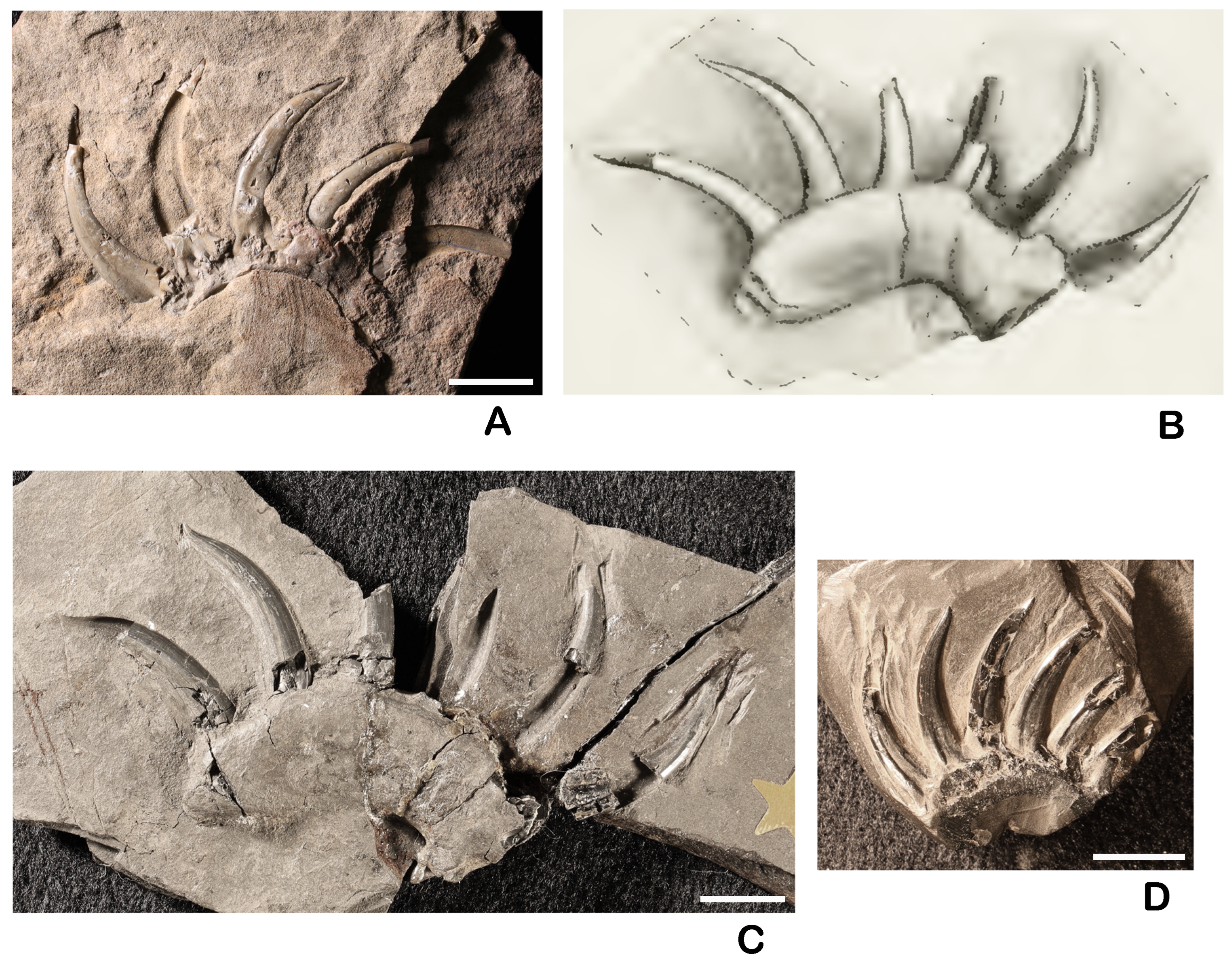
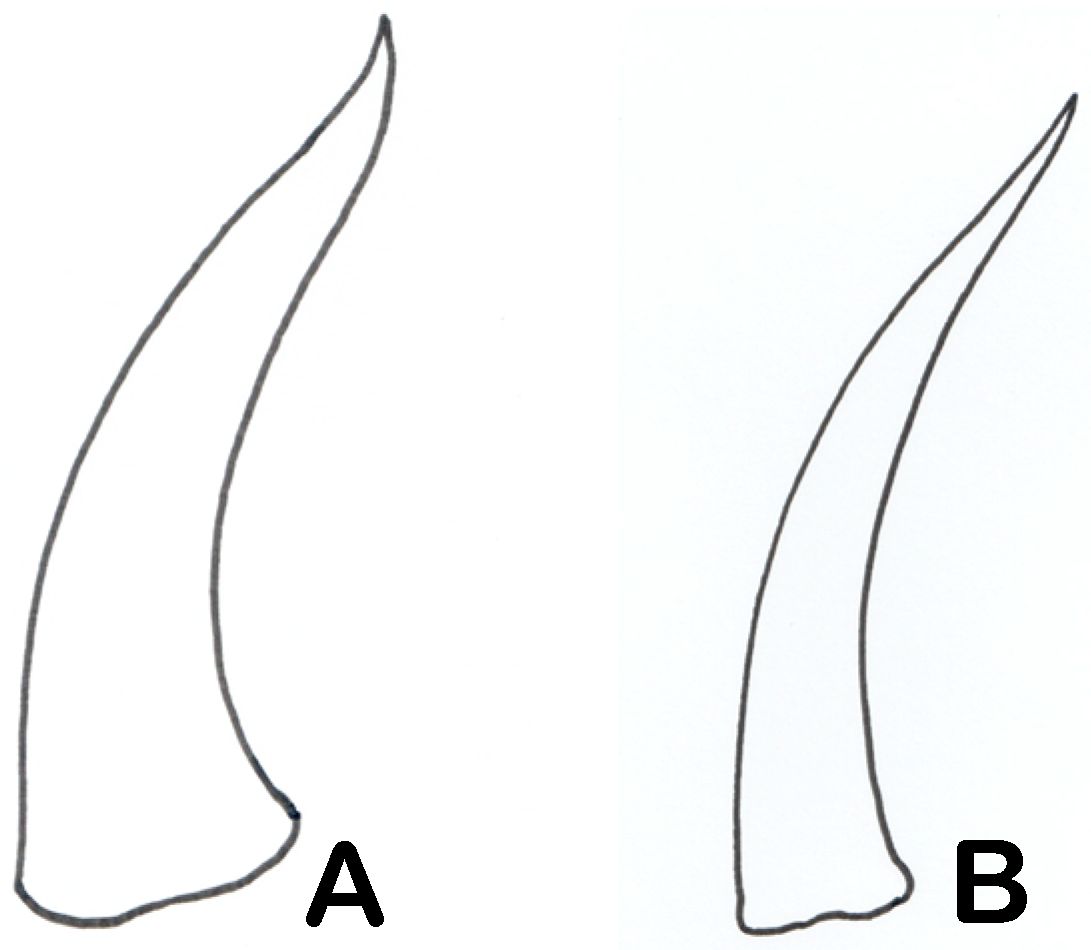
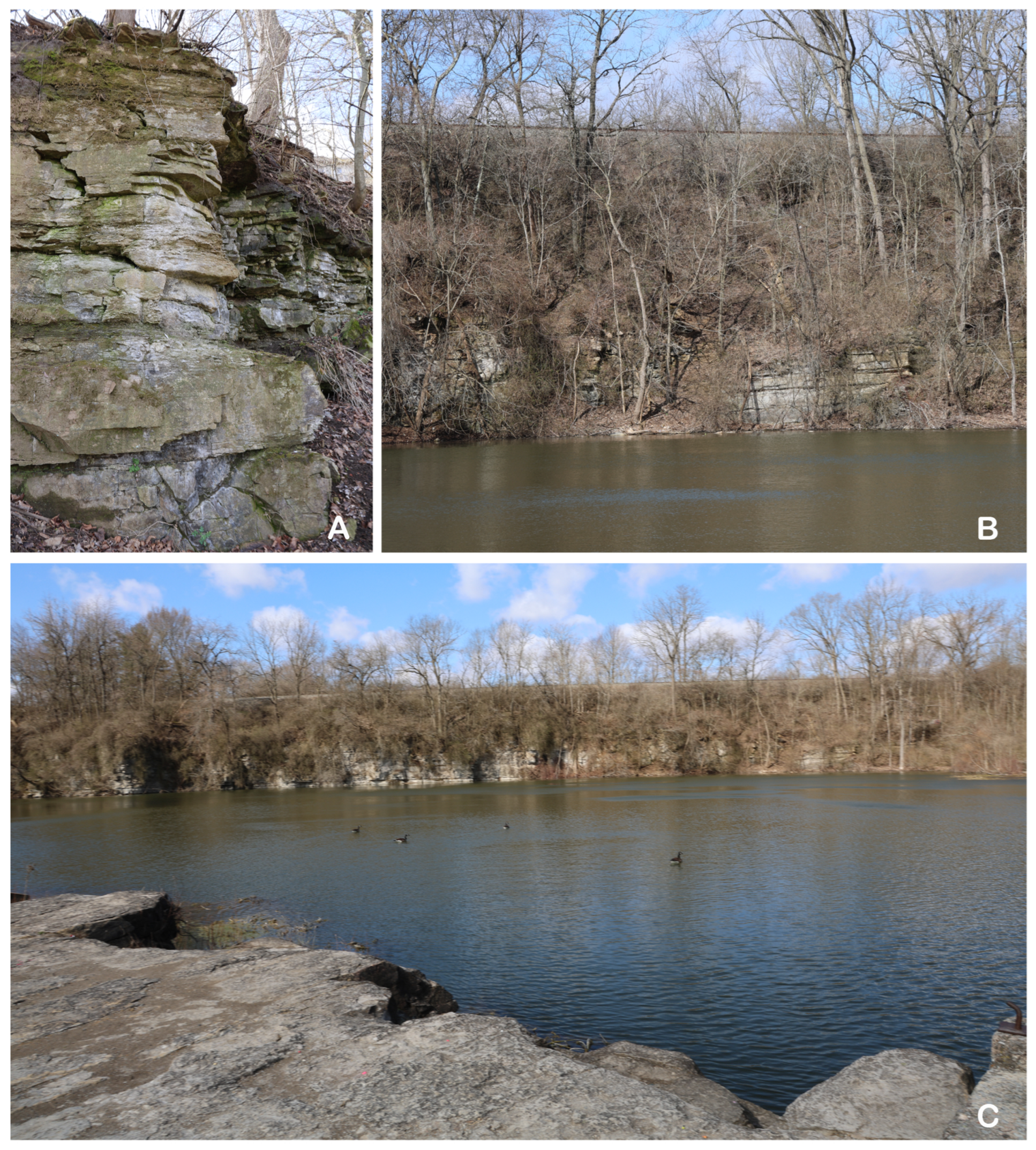
Disclaimer/Publisher’s Note: The statements, opinions and data contained in all publications are solely those of the individual author(s) and contributor(s) and not of MDPI and/or the editor(s). MDPI and/or the editor(s) disclaim responsibility for any injury to people or property resulting from any ideas, methods, instructions or products referred to in the content. |
© 2025 by the author. Licensee MDPI, Basel, Switzerland. This article is an open access article distributed under the terms and conditions of the Creative Commons Attribution (CC BY) license (https://creativecommons.org/licenses/by/4.0/).
Share and Cite
Babcock, L.E. Rediscovery of the Type Specimens of the Sarcopterygian Fishes Onychodus sigmoides and Onychodus hopkinsi from the Devonian of Ohio, USA. Diversity 2025, 17, 375. https://doi.org/10.3390/d17060375
Babcock LE. Rediscovery of the Type Specimens of the Sarcopterygian Fishes Onychodus sigmoides and Onychodus hopkinsi from the Devonian of Ohio, USA. Diversity. 2025; 17(6):375. https://doi.org/10.3390/d17060375
Chicago/Turabian StyleBabcock, Loren E. 2025. "Rediscovery of the Type Specimens of the Sarcopterygian Fishes Onychodus sigmoides and Onychodus hopkinsi from the Devonian of Ohio, USA" Diversity 17, no. 6: 375. https://doi.org/10.3390/d17060375
APA StyleBabcock, L. E. (2025). Rediscovery of the Type Specimens of the Sarcopterygian Fishes Onychodus sigmoides and Onychodus hopkinsi from the Devonian of Ohio, USA. Diversity, 17(6), 375. https://doi.org/10.3390/d17060375







